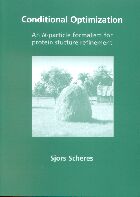
Conditional Optimization : An N-particle formalism for protein structure refinement / Sjors Hendrik Willem Scheres - [S.l.] : [s.n.], 2003 - Tekst. - Proefschrift Universiteit Utrecht


 |
Conditional Optimization : An N-particle formalism for protein structure refinement Conditional Optimization : An N-particle formalism for protein structure refinement / Sjors Hendrik Willem Scheres - [S.l.] : [s.n.], 2003 - Tekst. - Proefschrift Universiteit Utrecht |
NBC: 35.80: macromoleculaire chemie
Trefwoorden: conditional optimization, protein crystallography, ab initio phasing, molecular dynamics
In the standard crystallographic experiment, information about the phases of the reflections is lost. From the observed intensities alone, the electron density of the unit cell cannot be reconstructed and this problem is known as the crystallographic phase problem. At the resolution limits typically obtained in protein crystallography the phase problem is underdetermined and requires incorporation of additional information. Chapter 1 of this thesis describes existing, experimental and computational methods to determine and improve phases. The computational methods exploit prior knowledge about the content of the unit cell to supplement the limited experimental information. The quality of the available phase information typically determines how much prior knowledge can be expressed. In chapter 2 a novel refinement method is presented, called conditional optimization. The conditional formalism offers an N-particle solution for the assignment of topology to loose, unlabelled atoms. Thereby, conditional optimization allows expression of large amounts of geometrical knowledge about protein structures without the requirement of a molecular model, and thus potentially in the absence of phase information. Initial tests with a simplified structure and calculated data show that with this method, in principle, random atom distributions can be succesfully optimized and ab initio phasing of medium-resolution data can be achieved. Conventional methods for the estimation of phase probabilities fail for models of such low phase quality and a novel multiple-model procedure to estimate sA-values was necessary for these optimizations. In chapter 3 a mean-force potential for conditional optimization of protein structures is presented, which expresses knowledge about common protein conformations like a-helices, b-strands and loops. Using this generally applicable parameter set, conditional optimization of three small protein structures against 2.0 Å observed diffraction data shows a large radius of convergence, validating the presented force field and illustrating the feasibility of the approach. The application of conditional optimization to automated model building is explored in chapter 4. For three test cases with data to medium resolution and good experimental phases, conditional optimization yields models of comparable quality as obtained by the commonly used programs ARP/wARP and RESOLVE. Chapter 5 describes the application of conditional optimization to ab initio phasing of observed diffraction data. Low-resolution reflections and reliable phase probability estimates appear to be important for convergence. For the presented test case promising results are obtained, indicating that also with observed diffraction data succesful optimization of random atom distributions may be possible. Currently, excessive computational costs form a stumble block for common applicability of this method. Parallelization of the program may be a way of dealing with this problem and such a development is underway. From an optimistic point of view, and given the promising results described in this thesis, conditional optimization may then become a commonly applicable tool for protein structure determination. |

